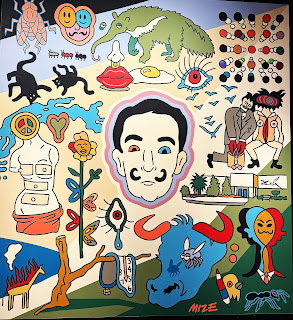 |
| Norton's Gateway No. 6 |
The Ann Norton Sculpture Gardens are a testament to the love of Ralph Norton for Ann Vaughn Weaver, his second wife. Norton was President of the Chicago-based Acme Steel. During his tenure, Norton and his first wife Elizabeth amassed an enviable art collection. In 1940, the couple moved to West Palm Beach, a more hospitable climate for Elizabeth's failing health. In addition to renovating a gorgeous home on what is now the Intercoastal Waterway, the couple established the Norton Gallery and School of Art. (The institution still exists today as the Norton Museum of Art.)
Every school needs instructors, and Weaver applied to be a sculpture teacher. Her impressive resume included participation in group shows at MOMA and the Whitney Museum of Art and two Carnegie Traveling Fellowships. She joined the Norton School of Art in 1942.
 |
| Norton's studio |
In 1977, Ann established a foundation to ensure the preservation of the Nortons' home, studio and sculpture gardens. Today, the Ann Norton Sculpture Gardens showcase Ann's work and host traveling exhibitions. During my recent visit, The Lost Bird Project and 'Rising' The Mystical World of Sophie Ryder were on display.
 |
| McGrain's Carolina Parakeet |
 |
| McGrain's Labrador Duck |
Replicas of each of the "lost birds" are on display at the Gardens, along with some of McGrain's drawings and Audubon prints of each species. The bronze sculptures beg to be stroked, which is exactly what McGrain intended.
McGrain's website is full of information about the Project and can be reached by clicking here. His interview in Smithsonian.com can be found here.
The Mystical World of Sophie Ryder provided quite a contrast to McGrain's birds. As I was strolling through the Gardens, I turned a corner and came upon Ryder's larger-than-life wire sculpture of Lady Hare. Ryder devised her creature as a companion to the half human-half animal minotaur. In Greek mythology, the minotaur is characterized as aggressive and violent. But with Lady Hare at his side, he becomes protective and loving.
Their bodies of Ryder's hare and minotaur are based on the figures of Ryder and her husband, respectively. Her sculptures vary in size from this monumental Lady Hare to human-sized works to intimate works appropriate for display on a tabletop. They are constructed from widely different materials, including wire, bronze, and marble. According to Ryder, her years of working with her hands have nearly eliminated her ability to make fingerprints.
 |
Ryder's Minotaur and
Lady Hare
|
To read more about Ryder and her work, click here.
Both McGrain's Lost Bird Project and 'Rising' The Mystical World of Sophie Ryder are on display at the Ann Norton Sculpture Gardens through the end of June.

.jpg)


No comments:
Post a Comment